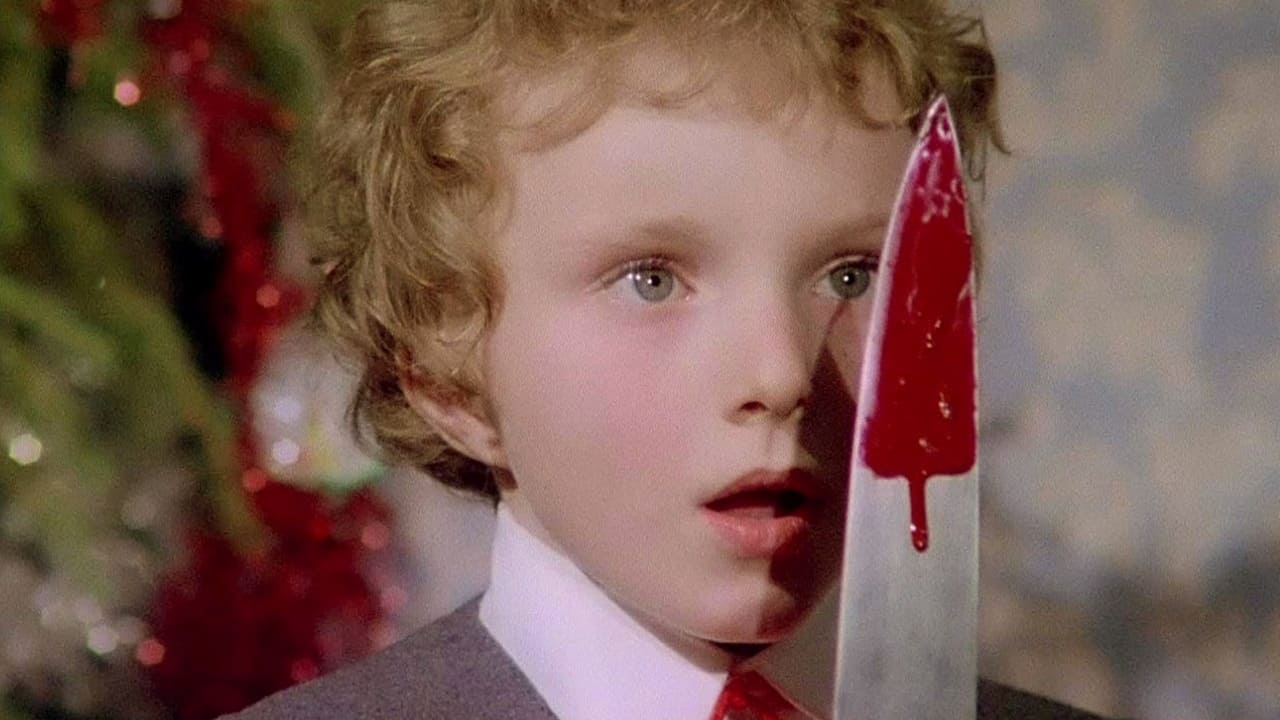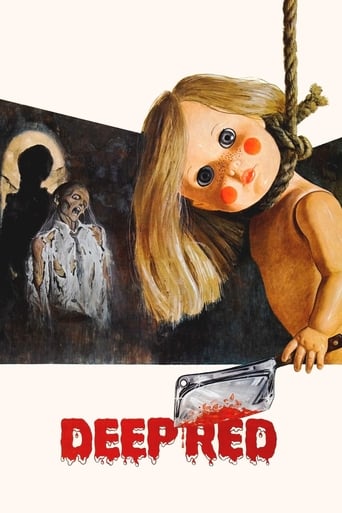

I gave this film a 9 out of 10, because it was exactly what I expected it to be.
... View MoreThe movie's not perfect, but it sticks the landing of its message. It was engaging - thrilling at times - and I personally thought it was a great time.
... View MoreAfter playing with our expectations, this turns out to be a very different sort of film.
... View MoreA terrific literary drama and character piece that shows how the process of creating art can be seen differently by those doing it and those looking at it from the outside.
... View MoreI think D.Argento in general, and his PRosso ( likewise The Bird with Cristal Feathers ) is quiet overrated by Giallo-lovers while IMO not so groundbreaking or original compared to some others 70's gialli. These have IMO more excitement,suspense, better locations or acting, and last but not least, better fetisjes, fashion, humor, or psychological insight. Some of the best, like The House With the Laughing Windows, I rated thus 10, and some mediocre examples, like this PRosso, 'only' 7.
... View MoreDario Argento's 'Deep Red' from 1975, gave me the chills. It's rare that a piece of art brings such primordial fear to the surface, with flair to match.The opening scene sets the tone masterfully. A static shot of a living room adorned with eccentric wallpaper and a modest Christmas tree, contrasted by a happy melody sung by a child, instantly sent me through memories of my childhood. After just enough time is given for this image to hit home, shadows appear on the wall of one figure stabbing another repeatedly with a large blade. This is followed by the blade thrown onto the floor in the center of the shot. What appears to be a child, enters the shot and stands over the blade. The images of my childhood were quickly slashed and twisted, replaced by ones of horror. Most of the scary scenes in this movie are equally as disturbing, on a visual and psychological level.Argento is known for this kind of work; Tones conveyed through imagery. This turns some people away from his work as not all of his stories are told by conventional means. I assure you, if this has been an issue of yours, this is the Argento movie for you.The plot follows a musician named Marc (David Hemming). After witnessing a murder, he believes he's seen a clue at the scene of the crime, but can't put his finger on it. An overzealous journalist; Gianna (Daria Nicolodi), arrives at the crime scene and suggests the two team up to find the killer. The plot thickens from there as more and more clues are presented, but not explained, forcing the viewer to become a detective as well. This all leads to a genuinely surprising and satisfying conclusion.Argento's imagery, camera-work, and lighting are as good as ever here. The difference with this movie is that the plot is told in a linear way, developed primarily through narrative. This is all complimented by great performances from every single actor (uncharacteristic of Argento's prior films).The only issue I have with this movie is the score. It is well composed and memorable, but does not match the context of the film. For example: A character will be slowly walking down a dimly lit hallway, tension being created by the camera-work, lighting, and pacing. All of the sudden a fast paced rock motif cuts in. I found this very distracting, especially considering how loud the mix is; however, the score was nominated for the Italian 'Silver Ribbon' award, so this is entirely subjective. Take my opinion with a grain of salt.All in all, Deep Red would be a masterpiece in my eyes, if I could get past its downright aggravating score. A classic in almost every respect.Verdict: 8.5/10
... View MoreFollowing the brutal murder of a renowned psychic, a pianist witness teams up with a reporter to investigate the psychic's death but the twisting case provides plenty of clues with no connection to each other and they race to stop the killer before he strikes again.This here was one of the better gialli's ever made and one of Argento's strongest efforts. What really stands out here is that, like most gialli's of the time-period there's a great deal of effort paid to the strong story as it's one of the finest ever concocted in the genre. This is set-up from the beginning with the fantastic murder scene committed in shadows on a living room wall while an eerie lullaby plays out in the background, and then once the killings proper start this draws out plenty more to like within this. Following up the lullabye, they find the connection with the house and the shattered memories locked up in there and that leads to the connection with the children's drawings found at the elementary school and the struggle to piece all these together with the lone puzzle piece that he can remember from the initial attack he he witnessed. As always, we're given a clue to who the killer is, but the killer is always seen with such an item that using it as the definitive piece to prove the identity would be impossible. Giving only the traditional pair of black gloves, a brown jacket and blond hair, which are very common items or traits, are nearly impossible to use as evidence to name a killer, is a very rare and even completely refreshing thing to use as a manner of identification rather than either hardly seeing who it is or by not even showing them at all. All of this works incredibly well in leaving the film with a strong and engaging central mystery that comes across really well here and setting the stage for the centerpiece kill scenes that are known for the visually-creative methods of killing people. There's plenty to like about these graphic, brutal kills that manage to look stunningly beautiful as well as horribly graphic and brutal, which makes for a much better time here, and given that there's a slew of strong suspenseful stalking scenes scattered along the way there's plenty of stylish and impressive work here. Even the score is pretty creepy, and is one of Goblin's best, all making for a good time to hold out over the film's very few negatives. The one main thing negatively about this is it has a tendency to simply stop the plot altogether and concentrate on a particular character trait that doesn't need to be in the story. Here, it's at for having a middle act that is completely devoid of any activity. He really does nothing except simply have play the piano at odd intervals which has no tension, no suspense, hardly anything other than the typical penchant for filming boring scenes with odd shots and angles. Likewise, the one thing about the soundtrack was that it was used as a sound effect, popping out occasionally to surprise the viewer. It works well the first time, but grows repetitive and doesn't work as time goes on. Otherwise, this here is one of the genre's best efforts.Rated R: Graphic Violence, Brief Nudity, and Language.
... View MoreDeep Red (1975) *** 1/2 (out of 4) -126 minute cut*** (out of 4) -105 minute English version Dario Argento's giallo about a musician (David Hemmings) in Italy who witnesses a woman get brutally murdered so he teams up with a journalist (Daria Nicolodi) to try and find out who the maniac is. DEEP RED, or PROFONDO ROSSO if you prefer, is certainly one of the most popular giallo films ever made but I think the quality of it is going to depend on which version you watch. Obviously the original American cut under THE HATCHET MURDERS title should be avoided since it loses nearly thirty-minutes worth of footage plus the majority of the gore. The 126-minute directors cut is actually the best version but for this review I watched the recently released "uncut English version," which clocks in at 105-minutes and features all the gore. I thought I'd enjoy this version the most but I must admit that the back-and-forth between Hemmings and Nicolodi was actually fun and with it missing here there's just a certain charm that the film is missing. The majority of the footage missing in this version is the back-and-forth flirting between the two and some character development. I know several people prefer this version but I think I'll go with the longer version on future viewings. As for the film, there's no question that it's a work of art as Argento's style is certainly at the top of his game and especially the magnificent cinematography. I especially love all the close-up scans of the floor where we see various items including the now somewhat legendary doll. There's also the masterful score from Goblin, which is just downright perfect and really sets the mood and atmosphere for the entire picture. Then there's the violence, which is certainly shocking at times but this is just Argento all the way. Both Hemmings and Nicolodi actually turn in good performances and they help carry the picture even when the story isn't the strongest. DEEP RED certainly deserves its reputation as one of the better giallo films out there but pick your version carefully.
... View More